In 2025, EV ownership generally saves you more money than a gas car thanks to lower fuel and maintenance costs, especially with government incentives that cut the initial price. As charging infrastructure expands and battery tech improves, charging becomes cheaper and more convenient. Although insurance can be slightly higher, the overall savings from fewer repairs and cheaper energy make EVs a smarter choice. Keep exploring to see how these benefits really add up for you.
Key Takeaways
- Electric vehicles (EVs) have higher upfront costs but are offset by government incentives, lowering total ownership expenses.
- Lower electricity costs and improved battery efficiency make EVs cheaper to operate annually than gas cars.
- EVs typically incur lower maintenance and repair costs due to fewer moving parts and longer warranties.
- While insurance for EVs may be higher, incentives and lower fuel costs generally result in overall savings.
- Technological advancements and expanding charging infrastructure further enhance EV cost-effectiveness by 2025.
Initial Purchase Price and Incentives
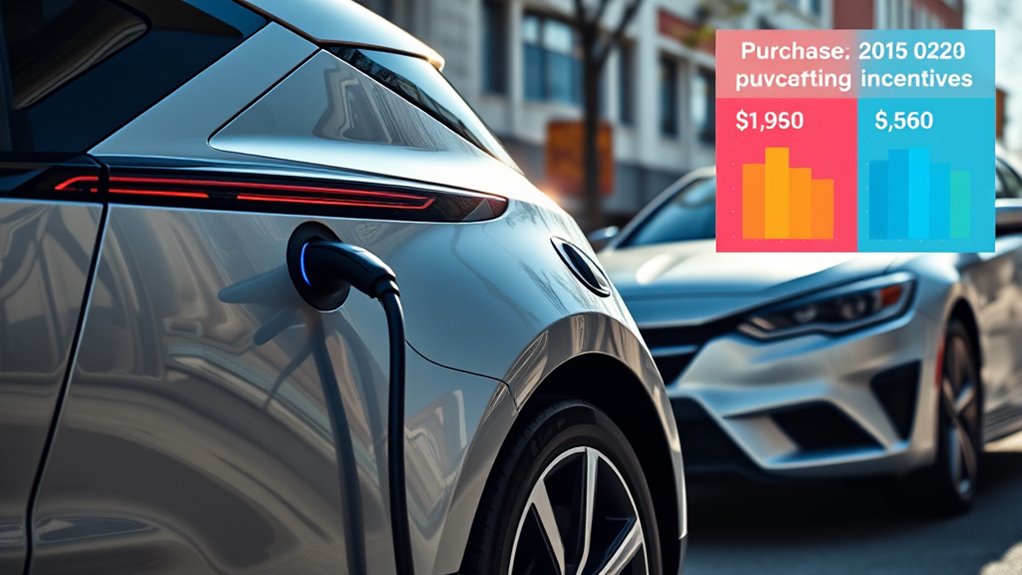
Although electric vehicles (EVs) tend to have a higher upfront cost than gas cars, incentives can substantially narrow this gap. Many government incentives, such as tax credits and rebates, reduce the initial purchase price of EVs, making them more competitive. Additionally, the growing network of charging stations enhances convenience and can influence your decision to buy an EV. These incentives vary by state and can cut costs by several thousand dollars. While the average EV price in 2025 is around $59,205, the combination of federal and local programs can significantly lower that figure. This financial support, coupled with expanding charging infrastructure, makes EV ownership more accessible and appealing, offsetting the initial cost difference compared to traditional gas-powered vehicles. Moreover, considering the for sale 100 market availability ensures you can find options that fit your budget and preferences.
Fuel and Energy Expenses Over Time
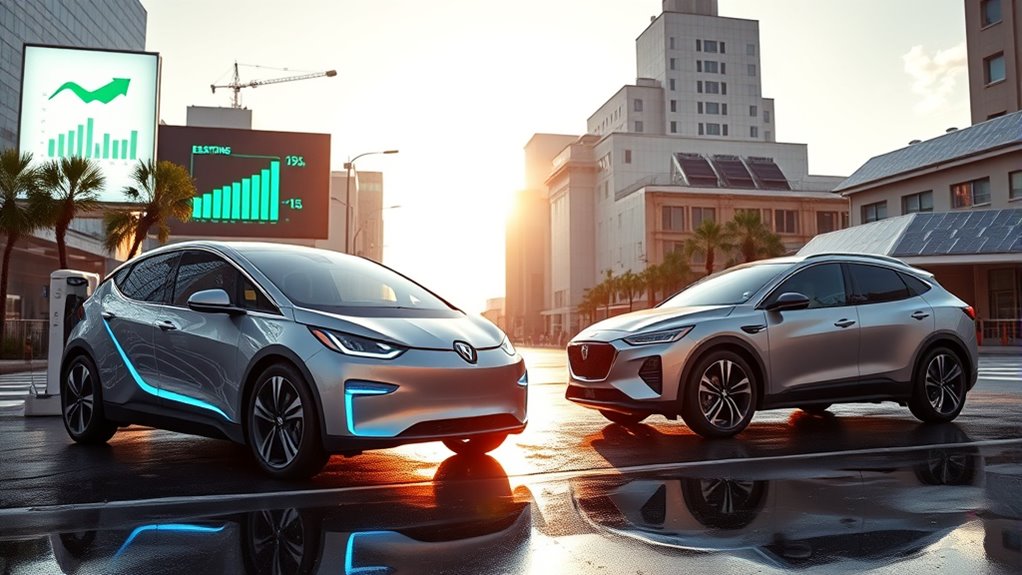
Fuel and energy costs play a significant role in the long-term ownership expenses of your vehicle. Electric vehicles benefit from advances in battery technology, increasing efficiency and reducing energy consumption. Additionally, expanding charging infrastructure makes charging more convenient and cheaper, especially when using off-peak electricity. In contrast, gas cars rely on gasoline, which remains costly per mile. Here’s a quick comparison:
| Aspect | EVs | Gas Cars | Savings Potential |
|---|---|---|---|
| Fuel/Energy Cost | Lower, due to electricity prices | Higher, due to gasoline prices | Up to $1,777/year |
| Charging Infrastructure | Growing, enhances convenience | No infrastructure needed | Reduced travel costs |
| Battery Technology | Improving, increasing range | No impact | Longer-term savings |
| Operating Costs | Lower, more energy-efficient | Higher, less efficient | Cost-effective over time |
Electric vehicles are also benefiting from battery advancements, which further enhance their long-term cost savings.
Maintenance and Repair Cost Differences
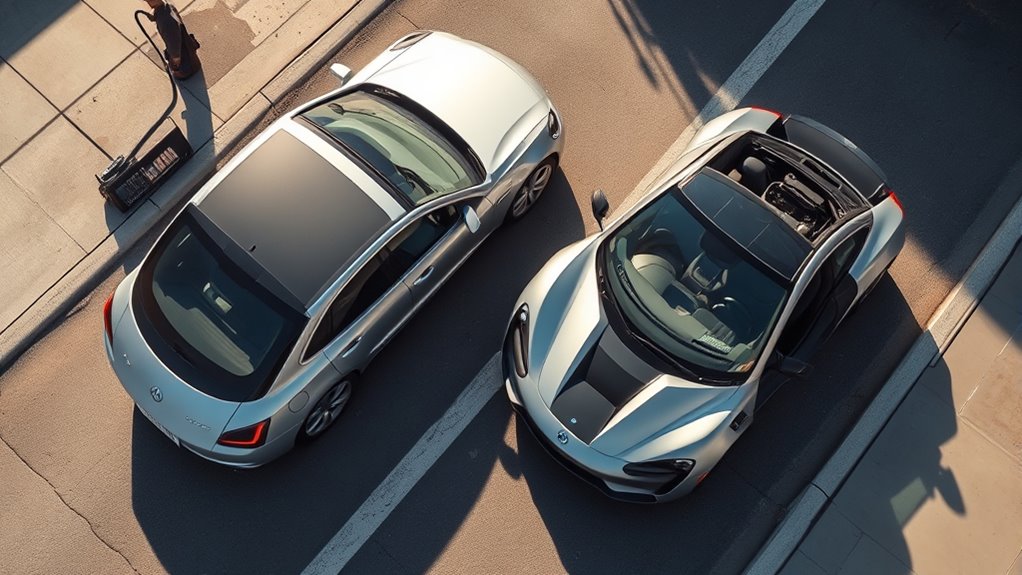
You’ll notice that electric vehicles have fewer moving parts, which means fewer repairs and lower maintenance costs overall. With longer warranties on batteries and key components, you’ll likely face fewer unexpected expenses. This can make maintaining an EV simpler and more affordable compared to traditional gas-powered cars. Additionally, Kia Tuning options for EVs are expanding, allowing owners to customize and optimize their vehicles more easily.
Fewer Parts, Fewer Repairs
One of the key advantages of electric vehicles is that they have far fewer moving parts than gas-powered cars, which directly translates into lower maintenance and repair costs. With advanced battery technology, EVs eliminate many components like oil filters, spark plugs, and timing belts, reducing potential failure points. This means fewer repairs and less frequent service checks. Additionally, the charging infrastructure is improving, making charging more convenient and reducing the need for costly repairs related to fuel system components. Because EVs lack transmissions and complex exhaust systems, repair costs are generally lower, and service intervals are longer. Over time, these factors contribute markedly to reduced maintenance expenses, helping you save money on repairs compared to traditional gas-powered vehicles.
Longer Warranty Coverage
Many EV manufacturers offer longer warranty coverage on batteries and key components, which helps reduce your maintenance and repair costs over time. Modern battery technology is more reliable, and manufacturers back it with warranties that can last 8 years or more, covering potential issues. This means you’re less likely to pay out of pocket for repairs related to the battery or other major parts. Additionally, as charging infrastructure continues to improve, EVs require less frequent service and fewer repairs, further lowering your costs. Longer warranties give you peace of mind, reducing the financial risks associated with unexpected repairs. Overall, this warranty coverage makes EV ownership more predictable and cost-effective, especially when combined with the growing reliability of battery technology and expanding charging infrastructure.
Insurance and Registration Fees in 2025

Insurance and registration fees for vehicles in 2025 vary markedly between electric and gas-powered cars, influenced by state policies and market trends. Insurance premiums for EVs tend to be higher, often around 17.5% more than gas cars, due to factors like repair costs and vehicle value. However, some states offer discounts or incentives to offset these costs. Registration fees also differ: some states charge higher fees for EVs to account for road usage, while others provide discounts or exemptions to promote adoption. Your actual costs depend on your location and driving history. Additionally, understanding positive thinking can help you approach these financial decisions with a more optimistic outlook. Overall, while insurance premiums for EVs may be higher, registration fee savings or incentives can balance the expenses, making the total cost more competitive in the long run.
Environmental Impact and Adoption Trends

Environmental impact plays a significant role in the growing popularity of electric vehicles. They produce zero tailpipe emissions, helping reduce air pollution and combat climate change. As battery technology advances, EVs become more efficient and affordable, encouraging adoption. Additionally, the expansion of charging infrastructure makes owning an EV more practical, easing range anxiety. Here’s a quick look at adoption trends:
| Aspect | Impact |
|---|---|
| Battery Technology | Improving energy density and longevity |
| Charging Infrastructure | Growing network supports widespread use |
| State Incentives | Encourage EV adoption through rebates and tax breaks |
| Public Awareness | Increasing concern about environmental issues |
| Market Share | Rapid growth, especially in California |
These trends foster a cleaner environment and accelerate EV adoption nationwide. Moreover, advancements in solar-powered charging solutions are beginning to complement EV infrastructure, further promoting sustainable transportation.
Long-Term Cost Savings and Resale Value
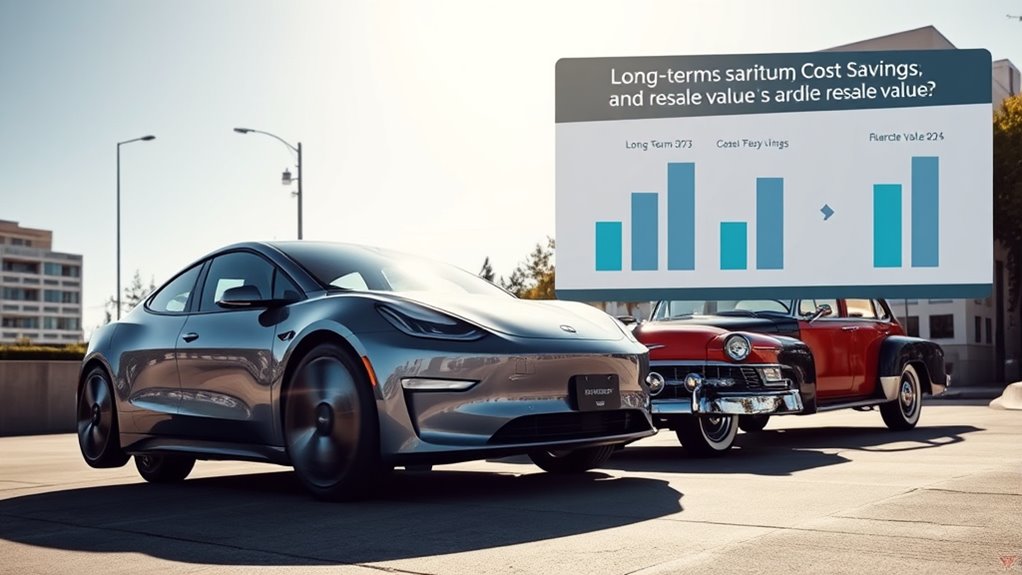
Long-term cost savings make electric vehicles a more economical choice over time, especially when you consider fuel and maintenance expenses. Improved battery technology means EVs retain their value better, boosting resale value. Plus, as charging infrastructure expands, owning an EV becomes more convenient, reducing costs related to charging access. You benefit from lower fuel costs since electricity is cheaper than gasoline. Maintenance costs drop notably thanks to fewer moving parts and longer-lasting components. Here are some key points:
- Better battery technology enhances resale value
- Growing charging infrastructure lowers charging costs
- Lower operating and maintenance expenses
- Incentives and tax benefits improve long-term savings
- EVs often depreciate less, increasing resale value
These factors make EVs a smart investment for long-term savings. Projector technology advancements also contribute to better overall ownership experiences, making EVs increasingly attractive options.
Overall Cost Effectiveness in 2025
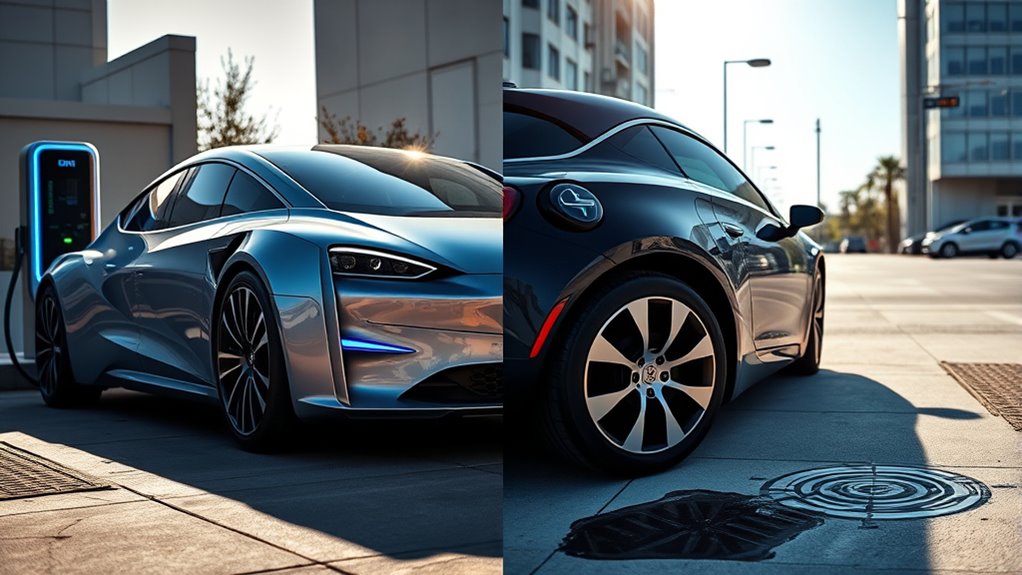
In 2025, electric vehicles have become increasingly cost-effective compared to gas cars, thanks to falling purchase prices, lower fuel costs, and reduced maintenance expenses. Government policies, such as tax incentives and stricter emissions standards, boost EV affordability. The expanding charging infrastructure makes charging more convenient and less costly, further lowering long-term expenses. Additionally, adopting mindful consumption practices can enhance overall savings and promote sustainability.
Frequently Asked Questions
How Do Regional Incentives Vary for EV Buyers in 2025?
Regional policies create incentive disparities for EV buyers in 2025. Some states, like California, offer substantial rebates, tax credits, or exemptions from fees, making EVs more affordable. In contrast, other regions provide limited or no incentives, increasing the upfront cost. You’ll find that these variations markedly impact the overall savings, encouraging EV adoption where incentives are strongest. Always check your state’s specific policies to maximize your benefits when purchasing an EV.
What Are the Hidden Costs Associated With EV Charging Infrastructure?
You might overlook hidden costs like battery recycling and charging station accessibility, but they can surprise you. Battery recycling impacts the environment and future costs if not managed properly. Charging station accessibility varies by location, and limited availability could mean higher expenses, such as installing home chargers or waiting at busy stations. These hidden costs add up over time, affecting your overall savings and convenience with EV ownership.
How Do Warranty Durations Impact Long-Term EV Ownership Costs?
Warranty longevity directly impacts your long-term EV ownership costs by reducing maintenance expenses. When your EV has a longer warranty, especially on the battery, you’re protected from costly repairs or replacements, saving you money over time. This extended coverage means fewer out-of-pocket expenses for maintenance and repairs, making your ownership experience more affordable and worry-free. Ultimately, a longer warranty enhances the overall cost-effectiveness of owning an electric vehicle.
Are There Significant Differences in Insurance Premiums Across States?
You’ll notice insurance disparities and premium variations across states considerably impact your costs. Some states charge higher premiums for EVs, often due to higher registration fees or insurance rates, while others offer discounts or incentives. These differences can make EV ownership more expensive or affordable depending on where you live. It is crucial to compare insurance costs in your area and consider regional incentives to determine your true long-term savings.
How Will Future Advancements Affect EV Resale Values?
Future advancements will likely boost your EV resale value by improving battery longevity, ensuring batteries last longer and retain more capacity. As battery technology advances, resale depreciation decreases because buyers will trust the vehicle’s reliability and performance over time. You’ll benefit from higher resale prices, especially as warranties extend and demand for newer, more efficient EVs grows. These innovations help you recover more of your initial investment when it’s time to sell.
Conclusion
Imagine you’re planting two trees: one grows quickly but needs constant care, while the other takes longer but offers steady shade. In 2025, choosing between an EV or gas car is similar. EVs often cost less over time, like that steady shade, thanks to lower fuel and maintenance costs. If you’re looking for long-term savings, EVs are the resilient tree that promises a brighter, more sustainable future, shading your wallet and the planet alike.









